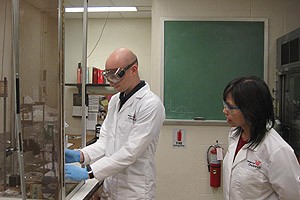
UC Undergrad Helps Develop Exceptionally Tiny Sensor
Timothy Meyung, an undergraduate researcher in the
McMicken College of Arts and Sciences
at the
, is part of a group working to develop tiny electrochemical sensors that may save those with medical implants from having to undergo extra surgical procedures. Led by William Heineman, head of the
, and graduate students Xuefei Guo and Julia Kuhlmann, the group hopes that these sensors will one day monitor the degradation rate of magnesium-based, biodegradable medical implants.
In Dr. Heinemans group, I have been working on the design of solid-state ion selective electrodes. Currently our design involves carbon nanotubes (CNTs) as ion-to-electron transducers, which have great potential to miniaturize ion-selective sensors, says Meyung.
In the past, medical implants were often made of titanium or other non-biodegradable materials, but now there is the option of magnesium-based implants which are biodegradable. With the titanium implants, a second surgery is required to remove the implant once it has done its job. However, the biodegradable nature of magnesium-based implants can potentially alleviate the need for a removal surgery because the implant will degrade inside the body.
According to Meyung, Many patients receive medical implants for different reasons. A main reason that an implant would be required is in the case of broken bones. A titanium implant will be placed in the human to help stabilize the bone structure and facilitate its healing. What is exciting about the magnesium implants is that they will degrade inside the body. This will make a second surgery that is often required to remove the titanium implant not necessary.
For this to happen there must be a way to monitor the degradation of the magnesium implant. That is why it is important for Meyungs team to design such a tiny sensorso it can be implanted into the body as a way to monitor the implants degradation progress.
Eventually, the miniaturized sensors will be tested in the in vitro Corrosion Characterization System (CCS) to determine their effectiveness. The in vitro CCS will be used to replicate the environment of the human body so we can assess the sensors performance and the effects of the implants degradation on surrounding cells.
Heineman has been impressed with Meyungs efforts. [Meyung] recently joined my group and has jumped into undergraduate research with a lot of energy and enthusiasm. Under the guidance of senior graduate student, Xuefei Guo, the sensors that he is developing are very important because of their exceptionally small size. Tim also has a good possibility of generating enough results for co-authorship on a journal article, he says.
The research project is part of an Engineering Research Center (ERC) grant that is funded by the National Science Foundation.
Related Stories
Ancient Maya blessed their ballcourts
April 26, 2024
Using environmental DNA analysis, researchers identified a collection of plants used in ceremonial rituals in the ancient Maya city of Yaxnohcah. The plants, known for their religious associations and medicinal properties, were discovered beneath a plaza floor upon which a ballcourt was built, suggesting the building might have been blessed or consecrated during construction.
OTR mural centerpiece of 'big' celebration of UC alumni
April 26, 2024
New downtown artwork salutes 18 alumni award recipients who personify UC’s alumni success.
From literature to AI: UC grad shares career path to success
April 23, 2024
Before Katie Trauth Taylor worked with international organizations like NASA, Boeing and Hershey, and before receiving accolades for her work in the generative AI space, she was in a much different industry: English and literature.
